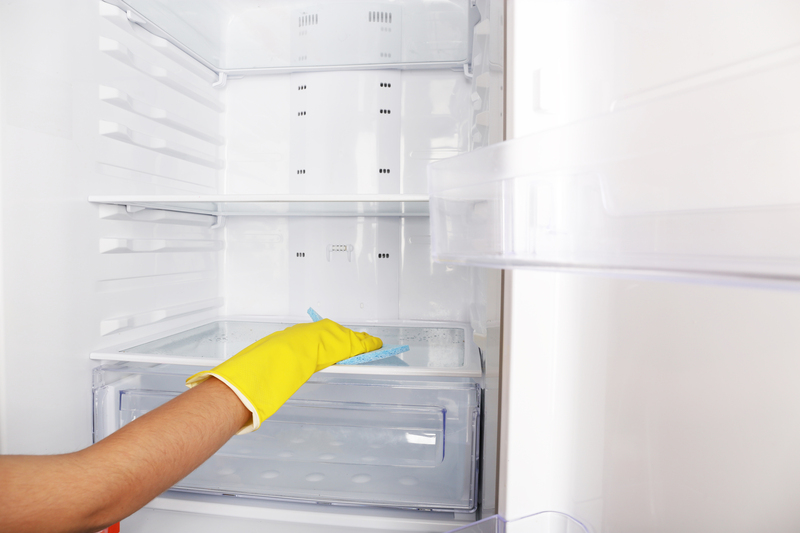From stale to fresh: Revitalizing spaces with clean air
Posted on 26/08/2025
From Stale to Fresh: Revitalizing Spaces with Clean Air
Introduction: The Importance of Clean Air in Indoor Spaces
In our fast-paced modern lives, we often focus on aesthetics, organization, and comfort when it comes to improving our indoor environments. However, one of the most crucial yet overlooked aspects is air quality. Transitioning from stale to fresh air isn't just about a more pleasant atmosphere--it's about health, productivity, and overall well-being. This in-depth article explores the science, techniques, and benefits of revitalizing indoor spaces with fresh, clean air.

Understanding Stale Indoor Air: The Hidden Threat
Stale indoor air refers to air that has become polluted, stagnant, or lacking in oxygen, often as a result of poor ventilation, high levels of contaminants, or an excess of volatile organic compounds (VOCs). Many people are unaware that air inside homes, offices, and commercial buildings can be up to five times more polluted than outdoors according to the EPA. This is due to a combination of factors, including off-gassing from synthetic materials, inadequate airflow, and accumulation of particulate matter.
- Allergens: Dust, pet dander, and pollen accumulate indoors, leading to allergic reactions and respiratory issues.
- Moisture: Excessive humidity encourages mold and mildew, which can worsen air quality and harm health.
- Odors: Cooking, cleaning, and human activity can create lingering unpleasant smells in closed environments.
- Chemical Compounds: Everyday products like paint, cleaning solutions, and synthetic furnishings release VOCs.
- Microorganisms: Bacteria and viruses thrive in stale, uncirculated air.
Without intervention, stale air can quickly become a breeding ground for health problems, from headaches and fatigue to serious respiratory conditions.
Health Benefits of Revitalizing Air Quality
Transitioning from stale to fresh air in your living or working environment can result in dramatic improvements to both physical and mental health. Here are some of the most significant benefits:
- Reduces Allergy Symptoms and Asthma Attacks by removing allergens and irritants from the air.
- Prevents Headaches and Fatigue, which are often triggered by poor indoor air quality.
- Boosts Mental Clarity and Productivity by supplying the brain with more oxygen-rich air.
- Decreases Respiratory Illnesses like colds, flu, and infections by minimizing pathogens in the air.
- Improves Sleep Quality--clean air promotes deeper, more restful sleep by reducing irritants that can disrupt breathing.
Clean, fresh air revitalizes the body and mind, making indoor spaces not only more comfortable but significantly healthier.
How to Identify a Stale Indoor Environment
Recognizing when your indoor air needs improvement is the first step in revitalizing your space. Here are common signs of poor air quality:
- Persistent Odors that linger even after cleaning or ventilation.
- Visible Dust Accumulation on surfaces and in air vents.
- Frequent Headaches or Fatigue among occupants.
- Increased Allergy Symptoms such as sneezing, watery eyes, and coughing.
- Mold or Mildew Growth in damp areas.
- Humidity Levels that feel uncomfortable--either too dry or too moist.
If you notice any of these warning signs, it might be time to consider revitalizing your indoor air to ensure a healthier, more vibrant space.
Effective Strategies for Revitalizing Indoor Air
1. Increase Natural Ventilation
The most effective, and often simplest, method of bringing fresh air into a space is to promote airflow from outdoors. Opening windows and doors, even for short periods each day, can make a dramatic difference. Cross-ventilation--where air enters from one side and exits another--ensures that old, stale air is replaced by oxygen-rich, clean outside air.
- Open windows during cool parts of the day to avoid energy loss.
- Use window fans or exhaust fans to encourage air movement.
- Replace air if possible after cooking, cleaning, or heavy indoor activities.
2. Utilize Air Purifiers and Filters
Modern HEPA air purifiers can capture up to 99.97% of particles as small as 0.3 microns, including dust, pollen, and bacteria. Activated carbon filters are particularly effective at removing odors and chemical pollutants. Investing in a high-quality air purifier ensures ongoing access to clean indoor air.
- Choose a purifier sized for your room's square footage.
- Regularly replace or clean filters according to manufacturer's recommendations.
- Consider purifiers with smart sensors for automatic adjustment.
3. Incorporate Houseplants for Natural Purification
Certain houseplants can absorb toxins and improve oxygen levels, making them a natural part of your air revitalization strategy. Popular species include spider plants, snake plants, and Bamboo palm. Not only do they help purify the air, but they also enhance overall mood and indoor aesthetics.
- Group multiple plants for greater impact.
- Place in areas with adequate sunlight.
- Water regularly, avoiding overly damp soil to prevent mold.
4. Manage Humidity
Balanced humidity (ideally between 30%-50%) is essential in preventing mold, dust mites, and other unhealthy organisms from thriving in your home or workspace.
- Use dehumidifiers in damp areas (like basements).
- Add humidifiers if the air is too dry (common in winter with heating systems).
- Fix leaks and address water damage immediately.
5. Regular Cleaning Routines
Dust and debris are contributors to a stale atmosphere. Establishing a cleaning routine, especially for soft furnishings, carpets, and air vents, will significantly reduce contaminants and revive the freshness of your indoor environment.
- Vacuum with HEPA-equipped machines regularly.
- Launder curtains and bedding often.
- Wipe down hard surfaces to eliminate dust buildup.
6. Limit Chemical Pollutants
Many store-bought cleaners, air fresheners, and synthetic materials release VOCs. Switch to natural cleaning products and avoid aerosols where possible to create a safer, more invigorating atmosphere.
- Use vinegar, baking soda, and lemon for DIY cleaning solutions.
- Choose low-VOC or zero-VOC paints, adhesives, and furniture.
- Avoid synthetic fragrances--instead, opt for essential oil diffusers.
Technological Advances: Smart Solutions for Clean Air
The rise of smart home technology has made maintaining fresh, clean air easier than ever. From smart air purifiers that monitor air quality in real time, to integrated ventilation systems that automatically adjust based on sensor data, technology is transforming the way we manage our indoor environment.
- Smart Air Quality Monitors: Devices like AirVisual, Awair, and Foobot track particulate matter, CO2, humidity, and VOCs, providing alerts and actionable recommendations.
- Whole-Home Air Exchangers: Mechanical ventilation systems that replace stale indoor air with filtered outdoor air, maintaining optimal oxygen levels and humidity.
- IoT-connected Devices: Seamlessly integrate air purifiers, humidifiers, and smart thermostats via smartphone apps for customized control.
Embracing the latest in air quality technology ensures not only comfort but also peace of mind.
The Role of Architecture and Design in Airflow
The way a space is designed and constructed greatly influences how air moves and refreshes within it. Architects and interior designers are increasingly prioritizing ventilation and airflow to create healthier, more sustainable environments.
- Open Floor Plans: Fewer walls and partitions allow air to circulate more freely, reducing stagnation.
- Strategic Window Placement: Cross-ventilation and the use of operable windows facilitate effective fresh air exchange.
- Passive and Active Ventilation Systems: Modern buildings often integrate mechanical and natural ventilation for year-round freshness.
- Green Spaces: Rooftop gardens, living walls, and atriums introduce plants and outdoor air, further revitalizing indoor spaces.
Thoughtful architectural choices can turn any space from stale to refreshingly vibrant.
Maintaining Clean Air: Best Practices for Long-Term Freshness
Once you've revitalized your space, follow these maintenance tips to keep your environment at its healthiest:
- Schedule Regular HVAC Maintenance: Change air filters every 1-3 months and have ducts inspected annually.
- Keep Windows and Vents Clear: Remove obstructions to enable proper airflow.
- Monitor Air Quality: Use smart sensors to track changes and adjust habits accordingly.
- Consistent Cleaning: Dust surfaces, vacuum carpets, and launder linens to minimize allergens.
- Introduce Seasonal Adjustments: In spring and fall, refresh air more frequently and deep clean problem areas.
A proactive approach will ensure your space remains revitalized and invigorating year-round.
FAQs: Enhancing Indoor Spaces With Clean Air
-
How often should I air out my home?
Ideally, air out your home daily for 10-15 minutes, especially after waking, cooking, or cleaning. -
What are the best houseplants for air purification?
Spider plant, snake plant, peace lily, and bamboo palm are excellent options for most indoor environments. -
Is it necessary to use both a dehumidifier and humidifier?
Depending on the season and your indoor climate, you may need one or the other to maintain optimal humidity (30-50%). -
Can I rely on air fresheners instead of purifiers?
Air fresheners mask odors but do not address underlying air quality problems; use purifiers for genuine clean air.

Conclusion: Transforming Your Space--From Stale to Fresh
In today's world, where most people spend up to 90% of their time indoors, revitalizing spaces with clean air is no longer a luxury--it's a necessity. Taking your environment from stale to fresh has sweeping benefits: improving health, promoting well-being, and enhancing the quality of life. Whether through ventilation, purification, or smart technology, there are practical solutions for every space and budget.
Make the commitment today to address your indoor air quality. Incorporate the methods above, and you'll soon notice not just a cleaner, brighter atmosphere--but a revitalized version of yourself, ready to thrive in every breath.
Related Resources
- EPA: Indoor Air Quality
- CDC: Indoor Environmental Quality
- World Health Organization: Air Pollution and Health
Remember: Every step you take towards cleaner air brings you from stale to fresh--revitalizing your space and your life.




